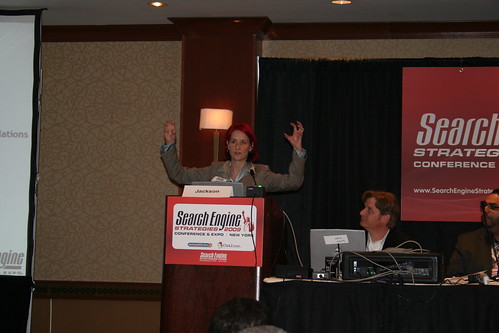News Search SEO: SES New York
Off to the organic track for some news and SEO learning. Our moderator is Mark Jackson, SEW expert and president/CEO of VIZION Interactive. The line up of speakers is: Greg Jarboe, president and co-founder, SEO-PR; Lisa Buyer, president and CEO of The Buyer Group; Dana Todd, CMO of Newsforce; and John Shehata, senior SEO manager at Advance Internet, Inc.
Dana Todd kicks things off.

Photo credit: Bas van den Beld
News is dead?
There’s a feeling that news is struggling. But in reality, news is exploding online. News sites have more 250 million readers — more than Facebook, with a broader demographic.
- 44 percent of all Web users visited newspaper Web sites in January of 2009.
- Newspaper digital audience has grown 60 percent in the last three years.
- Alternative news sources (search, Twitter, blogs) represent significant additional opportunities.
- News page views are up to trillions monthly.
Here’s a funnel:
Awareness
Opinion
Consideration
Intention
Sales
Brand advertising happens at awareness and opinion stages. Public relations happens at the awareness, opinion and consideration points. Search advertising happens at the intention and sales stages.
It’s not just about optimizing press releases. It’s about changing public perception, one story at a time. It’s about creating an emotional perception. She wants us to swear that no one will start their tactics before they set up their strategy.
Start with research and your strategy will write itself:
- Primary research
- Your questions should ultimately align with your campaign and brand goals:
- What are the key misperceptions about my product/industry that might be limiting my sales?
- What do people believe about my company?
- If I move the needle by X% how much market share or sales does that represent?
- Your questions should ultimately align with your campaign and brand goals:
- Secondary research
- Keyword research
Set your goals and metrics upfront and align to communications goals, not just sales goals. Plan a one to three year campaign!
Think of PR as content strategy:
- Once you identify the core branding and communication needs, what are the stories you need to tell and to whom?
- What’s the best way to reach that audience online and offline?
- Influencers + direct to consumer PR (this is too often ignored)
- Integrate offline promotions with online, and vice versa.
Sample strategies:
- Product/category awareness (“did you know?”)
- Corporate social responsibility (“watch a video of our green initiatives”)
- Crisis management (“our product is safe” or “we don’t need a bailout”)
- Build community
- Change political attitude
- I just want links (fill with crap and stuff it in wire stories — not a recommended long-term strategy)
Measuring outcomes:
- KPIs may look a lot like social media KPIs: buzz, links, social media activity, dwell times
- Document the relative value of a particular writer or publication in terms of their influence
- Use cookies and tracking tags wherever possible, plus unique phone numbers
- RSS and wire services may strip hyperlinks, tags
Free buzz tracking:
Techrigy SM2: There is a paid and premium version that will let you monitor terms for mentions. The cool thing is the story system they create.
Radian6: Great interface
Scout Labs
Next is John Shehata and he’ll be talking about tactics.
Why news search SEO? Half of Internet users search daily and 39 percent of them search for news. People expect the news to find them. People, places, events, hot subjects and crises and organizations are the top news searches.
There are traditional keyword research tools but some aren’t as good for breaking news search. They can show you what phrases are queried more but there are other types of tools that can help you with breaking news keywords.
- Yahoo Buzz
- SEOmoz.com
- Ask.com
- Google Zeitgeist
- Google Hot Trends – http://www.google.com/trends/hottrends (he likes this one best because it’s updated every hour and shows you all the angles that are catching interest for a topic)
Add Google Hot Trends to your Google Reader and then you can see the whole day’s trends at the end of the day. You can also get insight about your audience. When they search for certain topics is helpful knowledge.
Headlines:
- Spiders don’t understand pithy, poetic or witty headlines. You may want to write different headlines for the Web.
- Include keywords you want to rank for
- Use terms that people are searching for
- Be straightforward
- 5 to 12 words, no more than 21 words
- Create headlines that are fully understood on their own, without sub-headlines or images
- Remember print headlines sell the story. Optimized Web headlines tell the story.
Great news follows the inverted pyramid, which is SEO friendly. Don’t write for search engines but for people, with search engines in mind. Look out for acronyms or abbreviations; spell it out.
Sometimes you need to violate the AP stylebook:
- Use full names instead of last names.
- Use numerals instead of figures (9 instead of nine).
- Use passive voice to bring keywords in the beginning of the headline.
- Sometimes non-hyphenated words are more popular than hyphenated ones.
Google News:
- Only indexes articles three days old or less
- Only indexes it once
- Read Google News Help for Publishers
- Google News XML Sitemap and monitor it
- Section names (keywords in News XML Sitemaps)
- Host “most popular” and “breaking news” sections on your site
- Sub-headlines or beginning of article copy is pulled in as Meta description
Google News Search vs. Google Web Search:
Always upload your image to Google News. Include it on the top of the story. It can’t be a link. If you want to link to a larger version include a link that says “view larger” that they can use.
Lisa Buyer is going to talk about how news search SEO can be mixed with social media.
How fast does news travel on Google? Look beyond the press release:
- Facebook: Fan pages, groups, profiles
- Twitter: status, events, blogs, names, company names
- LinkedIn: corporations and groups
The PR Opportunity:
There are millions of users on each platform. Offer newsworthy angels and talk about news in an optimized, interesting way.
The results?
- News coverage in the search engines
- Communicate your social media channels to the public
- Drive traffic to social media channels
- Get followers, links, fans
Twitter and news search: Twitter updates can be indexed in Google News. [Really? Maybe I heard that wrong.] The media is on Twitter and is using it to break stories as well as look for stories. Your Twitter PR strategy can report the news, interact with media and connect with clients and prospects.
Employees on Twitter: @youremployeename. Twitter shows up in search and Google Alerts.
Watch out for irresponsible employees on Twitter. An employee saying “eff you” to a client is not a good idea.
- Talk with your employees about their social media use.
- Educate them on how it could show up in search news and effect the company’s search news.
- Create an action plan for online reputation management.
- Make a PR plan for prevention and reaction.
Lessons:
- Think before you tweet.
- Avoid online gossip.
- Use Google Alerts to track your news, names and brands — at a minimum.
- Have employee policies on social media.
- Say online anything you want to be aired on the 6:00 news.
When it comes to PR and news SEO, the benefits are slow and steady but pitfalls can quickly hurt you.
Greg Jarboe is going to wrap up the presentations.
Previously he has shared case studies of what news search SEO generated:
- $22.5 million in ticket sales for Southwest Airlines in 2004.
- 1.3 million searches on SuperPages.com for florists in 2005.
- 450,000 unique visitors to The Christian Science Monitor in 2006.
- 1,100 attendees to the Wharton Economic Summit in 2007.
- 36 percent increase in searches for Better Homes and Gardens brand names in 2008.
The quantity, quality and relevance of links count towards your rating.
“For ranking in Google, however, the main benefit of a press release is not direct links or PageRank from the press release directly; it’s primarily the people who decide to write an article and link because of that.” — Matt Cutts
There are a number of newspapers that are closing or are moving to primarily Web editions. If you’re doing traditional public relations, good luck. Pay attention to the new stuff because the old stuff is going away quickly.
The buzzing blogger community can be an excellent place to generate interest. They are helping to fill the void that is being created with the decline of traditional news. They’re filling the place because the appetite for news is still there. The best way to get other sites to create relevant links to yours is to create unique, useful content.
Optimized press releases can rank first in search results. Include an image and get the visual advantage. Contact influential bloggers the day before the press release goes out — the blog is the new press. They’re just as interested in getting the scoop as traditional media counterparts. Traditional media picks up stories from blogs as well. Combine blog outreach and press release optimization to build links.
Q&A
What types of news stories shoot up in search results faster?
John: Your physical proximity to the source of the story, how many people click — there are certain factors you can’t control. But in your niche it could be easier to get high rankings
Greg: There’s no short cut like including “breaking news” in your headline. Sometimes the most popular stories aren’t really “news” but tips.
Are there best practices for showing up in Google News?
Greg: Submit a specific URL to Google News for consideration. This may take creating a “top stories” page on the site.
What are some tips for a company that has a good chunk of staff doing SEO and blogging that we want them to align with the brand and the public mission statement without curbing the efforts and creativity of staff?
Lisa: I had some policies in place as far as client names and brand name use. The best thing to do is sit down with the group and explain what could happen and get all the ideas together to form guidelines. You want to have the self expression — it’s the beauty of social media — but you need guidelines. Keep the conversation going.
Updating stories on the NY Times site changes the URL. That seems not to be a good idea.
Greg: That is a bad idea and the New York Times is working to change that. They’re struggling to make those adjustments.
John: When you have substantial updates, don’t update the same story. Write a new story.

4 Replies to “News Search SEO: SES New York”
PR releases are one of the main tools for SEO ranking. I find it provides a sudden boost to ranking in a very short time scale. definately worth doing.
Thanks for your resources and input here.
Tracy
Thanks so much Virginia for this good updates, good strategies always gives you good returns if you do sees on sales or popularity. Think of the audience needs put yourself at the costumer end and ask what you need for such XXX, YYY company and sure you will get some good answers from yourself and then go for the best..
Thank you so much for live-blogging this session. Lots of good take aways for our clients who often struggle to figure out why they should do press releases.
News SEO is a very important part of your seo profile. I have used it and got large popularity and visibility.Whenever i release an optimised press release i always rank in the first page og google news which gives me a lot of visitors and some link bait too!
LEAVE A REPLY









